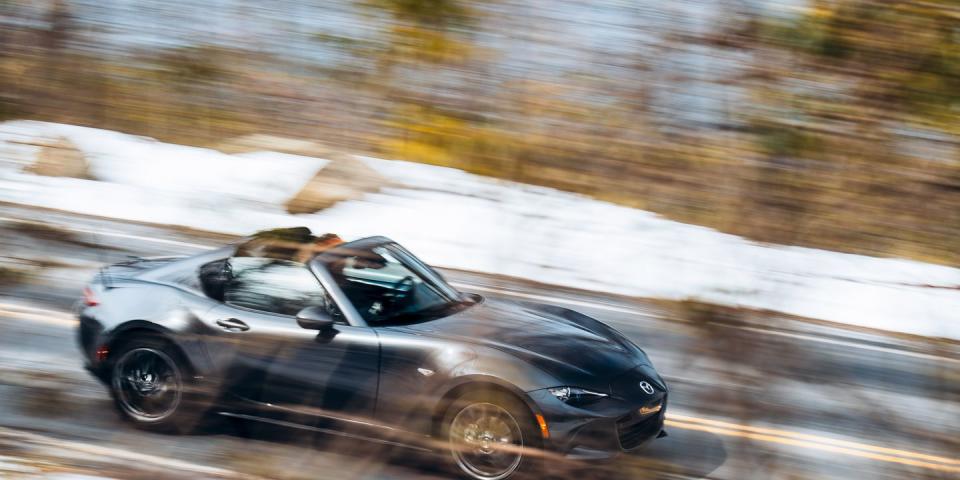There's More to the 2019 Miata Than More Power

Last month, we told you about the possibility that the 2019 Miata would have significantly more power courtesy of a heavily-revised Skyactiv 2.0-liter engine. Thanks to a friendly Mazda dealer in Canada and some of the insiders at Miata.net, we now know quite a bit more about how the new Miata will make its power, as well as a few other pieces of information that will make some buyers hold onto their money and send others rushing to the dealership for a 2018 model. We contacted a representative for Mazda USA who refused to confirm the validity of the leaked document, but that’s par for the course in a situation like this.
2017 Miata RF shown above - Ed.
Let’s start with the engine. The power figures are impressive–181hp at an as-yet-unspecified engine speed and 151 lb-feet of torque. These are improvements of 26 hp and 3 lb-feet respectively. The only way to increase horsepower that much without increasing torque? You have to spin the engine harder. The current car has come in for some criticism because its 6800-rpm hard redline was 400rpm below the redline of the previous-generation NC Miata. Sure enough, the documentation provided to dealers refers to the “increased rev capacity” of the revised engine.
“Ultra-light” pistons, lighter connecting rods, and a new crankshaft are just part of it. The 2019 engine will have larger intake and exhaust ports and a high-lift camshaft. Both intake and exhaust systems will have higher flow and there is a new throttle body. These are the kind of changes that racers have been making on Miatas for twenty-plus years now, but the new ND2 Miata will have them from the factory.
One potential fly in the ointment: For 2019, the Miata will have a dual-mass flywheel. These are often heavier and they are always more complex. Mazda claims it’s to handle some of the noise, vibration, and harshness issues brought on by the more powerful engine. Another annoyance: Drivers who like to listen to compact discs will not be pleased to hear that the CD player is gone in the new car.
The two big changes outside the powertrain: Smart City Braking System, which is meant to reduce pedestrian fatalities at the cost of whatever drink you happen to have in your hand or cupholder at the time, and a long-awaited telescoping steering wheel. The ND’s cockpit is noticeably tighter than that of its predecessor so this is a big deal for those of us who are on the middle-to-outer ranges of human proportion. There’s also a rearview camera now for when you’re backing your SCCA National Solo Miata up to your tire trailer.
The trim levels available for Miatas in Canada don’t exactly match the US-market ones. Their trim levels of GX (base), GS (mid-tier) and GT are similar, but not identical, to our Sport, Club, and Grand Touring. For 2019, Canada will lose the GX and instead get a better-equipped GS as the base car. They will get a GS-P that has the BBS/Brembo combination as standard. What this means for the 50-state market is anybody’s guess. Will we lose Sport, leaving us with just Club and Grand Touring?
Canadian soft tops will also get an optional brown convertible top and three different colors of leather in the RF Grand Touring. Traditionally, US-market cars have had fewer color options than Canadian cars, so there is nothing to suggest that the brown top will also make it south of the border.
According to sources on Miata.net, 2018 production has already ended to make room for the 2019 changeover. Which leads to the obvious questions:
0. If you have a current ND Miata, should you trade?
1. If you’re planning on buying an ND, should you wait?
Given that there are a few ECU tuners who are offering a ten or fifteen horsepower boost for the ND at prices below $500, it’s hard to argue that anybody who likes their current Miata shouldn’t just keep it. It’s also worth noting that the extent of the changes to the engine mean that the existing forced-induction kits will have to be revised, which will take time and effort. So if you want to turbocharge or supercharge your ND, you are better off sticking with the car you have.
For new buyers, the choice will be tougher. Pricing has not been released, and there are some dealers out there who are offering some very competitive numbers on in-stock 2018 and 2017 models. Most of the cars coming off the boat right now from Japan have the new blood-red soft top. I’ve seen it in person and it’s absolutely gorgeous. Do you really want to give up the whole summer and fall just so you can have a little more power in a car that arguably doesn’t need it to begin with?
Our final advice: Miata intenders who can’t live with the thought of not being able to soar past seven grand on the tachometer should grit their teeth and wait, with the understanding that there will be a cost in both money and time for doing so. Everybody else should consider making a deal on an in-stock 2018. Roadster weather is right around the corner for most of the country. As Jim Morrison noted, the future’s uncertain and the end is always near...
You Might Also Like

 Yahoo Autos
Yahoo Autos 